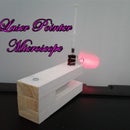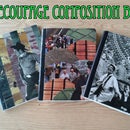Introduction: Restoring Old Paintbrushes
I've been a house painter for years. I've used just about every kind of brush made and I've learned one thing- you get what you pay for. I use Wooster 2 1/2" angled brushes for just about everything. They have quality bristles, they fit my hand nice and they last a long time. they're also kind of pricey. Since I'm self-employed, materials and tool costs come out of my profits. I make a brush last.
My grandfather always cautioned me to 'pinch a nickel til the Indian rode the buffalo'. I get my money's worth out of things. When my brushes start to get ragged I don't throw them out, I recondition them. This involves meticulously removing the paint build up, cleaning the brush very well and reshaping the bristles.
Step 1: Removing the Built-Up Paint
A paintbrush's worst enemy is paint build up. This is particularly bad around the ferrule, the metal band that binds the bristles to the handle. Every time the brush is used and cleaned, a little bit of paint is left behind. This causes the bristles to splay out preventing you from getting a clean line.
I used mineral spirits in a shallow pan to soak the brush. It doesn't have to be submerged- if the brush sits in a small puddle of spirits it will absorb it through capillary action. I let it sit for 30-60 minutes depending on the amount of build up.
After the brush soaked for a bit I used a putty knife and a wire brush to carefully remove the paint build up. I used the putty knife to gently scrape the base of the bristles from the ferrule down to the tip. I used the wire brush to brush the bristles in the same direction. Never force the bristles in the other direction, whether with a wire brush, putty knife or even water. Brushes are one-way.
I payed special attention to the sides of the brush. Paint always seems to collect here no matter how thoroughly I clean it. The wire brush is very useful there. I placed the brush in the puddle of spirits and gently bent the bristles to make them fan out and rocked the handle back and forth. This causes the bristles to spread and contract and 'pump' the spirits through, flushing out any loose paint. I did this repeatedly while I removed the paint to keep it wet and free of paint.
Another place that paint builds up is on the very tip of the bristles. Quality brushes have bristles with polished tips. The brush is put in a machine that moves the bristles in a circular motion on an abrasive surface. This rounds the ends of the bristles for a smoother, less streaky finish. While this makes for a better paint job it also means that paint tends to stick to the ends. At the ferrule the bristles are bound tightly together, so the putty knife and wire brush can get enough pressure to scrape the paint away. The ends of the bristles tend to spread out when you press on them making the paint hard to remove.
I chucked a 4" wire wheel into my hand drill and used it to scrub the bristle tips. I pressed the brush down flat and raised the handle vertically to make the bristles fan out and I kept the wire wheel moving back and forth. Make sure that your drill id turning in the right direction so it doesn't bend back the bristle tips. Go ferrule-to-bristle always.
While I had the wheel in the drill I also cleaned the rust and paint build up from the metal ferrule. This makes the brush more comfortable to work with.
Finally I took the brush over to a dead grapefruit tree and gave it a good Bob Ross style whack. The idea is to wave the brush back and forth quickly so that the bristles strike a surface on each pass. This knocks the excess spirits out of the brush so it will be easier to clean in the next step.
Step 2: Cleaning the Brush
The brush was now 'clean' but it was full of loose paint bits and oily mineral spirits. I took it to the sink and rinsed it thoroughly with warm water. I worked some dish detergent into the bristles and brushed it well with the wire brush to remove all the loose paint. I rinsed it again with warm water and fanned out the bristles to pump the clean water through. I smoothed down the bristles and left it in the sink handle up to drain a bit.
Step 3: Shaping the Bristles
Once the brush dried the bristles spread out and looked really shaggy, All the agitation from removing the paint put them in disarray. The first step was to comb the brush. The sell fancy metal combs for this purpose, but an old rat tail styling comb works just as well plus the pointy handle is handy for working out chunks of paint.
Next I saturated the bristles with Murphy Oil Soap. I did this gently to prevent it from lathering. When the bristles were soaked with the oil soap I combed them again and then used my fingers to carefully shape the bristles. The thick soap acts like hair gel and holds the bristles in shape. It also moisturizes and conditions the brush, making it soft again. I hung the brush up with the bristles hanging down and left it in the sun to dry for a few hours. If the brush is in really bad shape, it can be left for several days..
Step 4: Finishing the Brush
When the oil soap was stiff and dry to the touch I took it inside for the final rinse. By now the bristles are holding a better shape so I smoothed them down and hung it up again to drain.
There always a few damaged bristles near the edge of the ferrule that want to stick out at an angle. These were trimmed carefully with a hobby knife as close to the ferrule as possible. After trimming I hung it back up to dry completely overnight. In the morning I put it back in it's cardboard cover, or shuck, and put it back in my brush box.
All together, this is about 15 minutes of work, or less if I'm doing multiple brushes. Since these brushes cost about $15 a piece that's time well spent. Once brushes get too bad to clean up they're not ready for retirement yet. I use those for doing wooden siding and rougher surfaces. Finally, the splayed out raggedy brushes become stucco brushes. I paint part time, about 2 days a week, and these brushes last for years with this treatment.
Go pinch those nickels.













